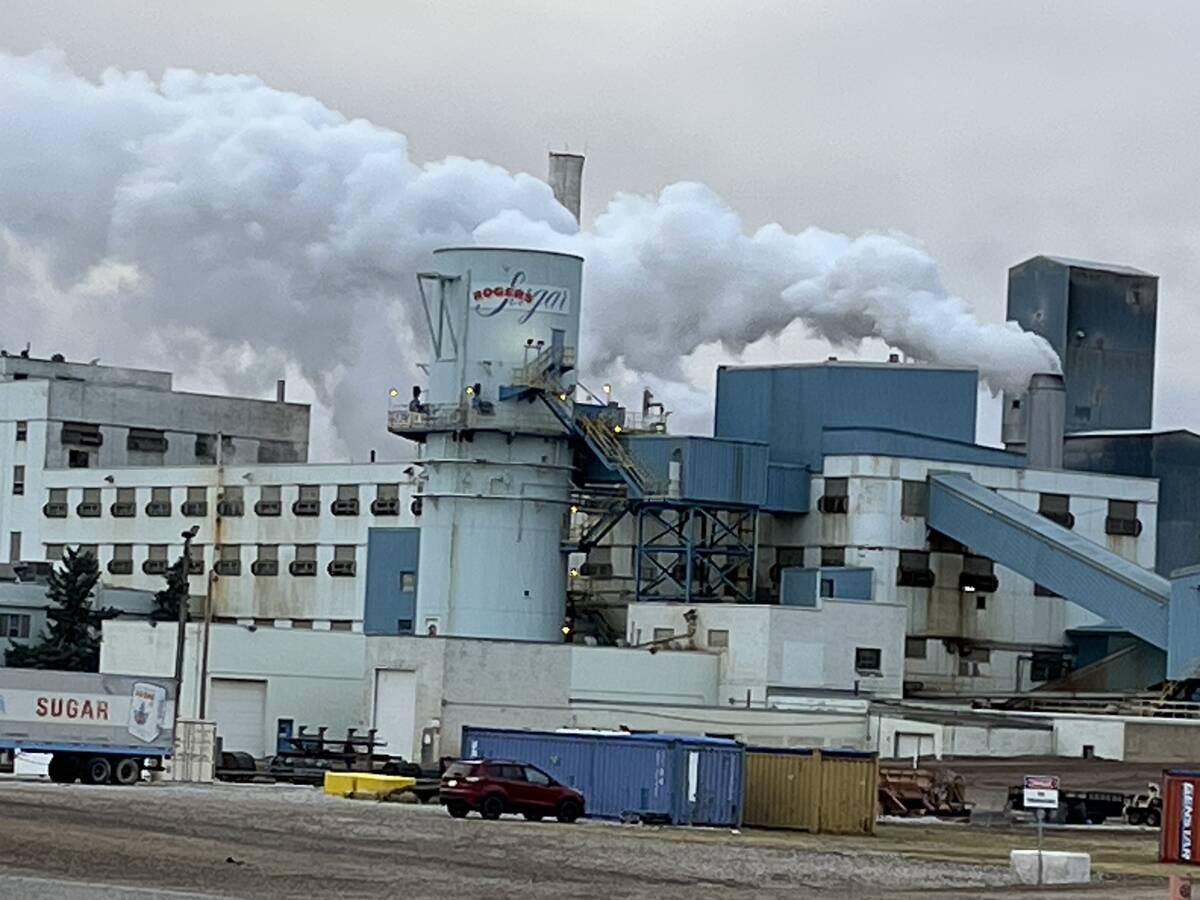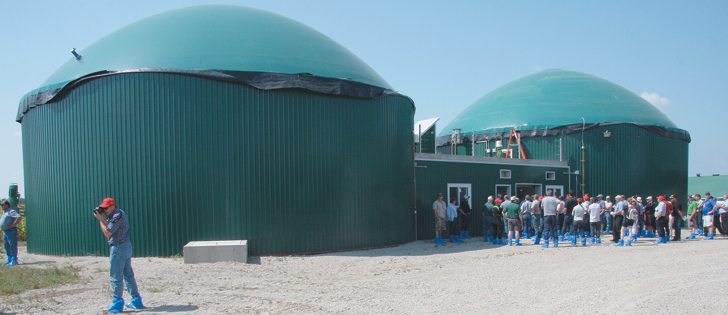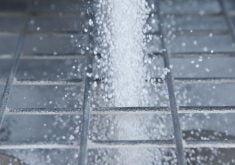Creating power not just a pipe dream | Bio-gas units turn waste products into an asset that lowers costs
GUELPH, Ont. — The bio-digester and generating station on the Clovermead dairy farm has been feeding power into the electrical grid for more than a year.
It’s all going so much according to plan that it’s about as exciting as watching a clock on the wall, which is exactly what the Whale family wants.
Korb Whale, a civil engineer by training and trade, returned to the family farm near Drayton, Ont., a decade ago to become the seventh generation manager of the operation.
While away from the family dairy business, Whale designed bio-gas projects and studied with an American dairy producer who had been running his own bio-gas plant for 25 years. He returned to Clovermead convinced that the latest bio-gas technology could be applied to the family farm and its 150 head of cows.
Read Also

Sugar beet harvest underway in southern Alberta
Alberta Sugar Beet Growers hosts field tour to educate the public on the intricacies of the crop, its harvest process, and contracts with Lantic Sugar
Today, the family operates a $3 million bio-gas facility that not only sells electricity to the grid but has given them the biological tools to run their dairy in a more sustainable, environmentally friendly manner.
“And that was our goal from the beginning,” he said.
“Selling power to the grid is the factor that made other things possible for us.”
The family had first hoped to simply sell raw bio-gas into the high-pressure natural gas pipeline that crosses their farm, but there were problems.
The gas buyer required that the bio-gas be cleaned to a much higher standard than straight bio-gas. The cleaning equipment would cost $500,000 and hookup to the pipeline already on their property would cost another $500,000.
However, the real wrench in the works came when they found out that the buyer would pay only the going price for natural gas in Alberta.
“Put the numbers together and we were looking at a payback of about 150 years,” he said.
“In a sense, we liked the efficiency of gas better because it meant we could sell about 60 percent of the energy our bio-gas digesters could produce, but that was a give-away price. Selling electricity means we sell only 40 percent of the energy we’re capable of producing. But the economics are better, so that’s why we choose to generate power for the grid. Hookup to the power grid cost almost as much as hookup to the gas line, so that factor was a wash.”
Whether they sell gas or electricity, the family tries to use as much of the wasted heat as possible, but most of it is vented to the atmosphere.
The first component in the operation is bio-gas production, starting with digestate in the mix tank. The main source is manure and bedding from the farm.
Off-farm materials arrive on the farm in large, blue, poly tanks, which are heated with excess heat from the system. Materials include waste and bedding from a chicken-processing plant, wash water from a cookie factory, banana peels and onion skins.
The concoction is blended, agitated and heated in the mix tank at 40 to 50 C. Water is then added so it can be pumped to the pasteurization plant, where it’s cooked for an hour at 70 C to kill pathogens. All heat used in the process is re-captured waste heat from the system.
A pump is triggered automatically every two hours to move a small amount of the pasteurized liquid into the bio-digesters.
Whale said all the equipment from the input lid on the blue poly tank to the outlet spouts on the bio-digesters cost $1.5 million.
The flat top building between the two bio-digesters is the control room, containing heating manifolds and other equipment, as well as a platform roof so that staff can go up in person to check the bio-digesters.
The same bio-digesters would have been used whether they sold gas into the pipeline or power into the grid. Together, they can produce 500 kilowatts for the grid, but the Whales have been able to sell only half that amount. The bio-digesters are identical, each holding 1,000 cubic metres and standing 24 feet high.
Each flexible rubber dome consists of two layers: the inner bubble rises and falls, depending on the volume of gas it holds, while the outer bubble always holds the same shape because air is pumped between the two membrane layers.
The $500,000 electrical generation station consists of a German-built Leroy-Somer generator powered by a Man bio-gas converted diesel engine. It is a six-cylinder engine, with the bio-gas ignited by sparkplugs.
“The life expectancy before a major overhaul is 60,000 hours,” he said.
“That’s eight years of continuous operation, but the maintenance schedule is very strict. We have daily maintenance, plus we run oil samples every 250 hours. The service crew comes out on a regular basis. They detected a problem on one of their visits a while ago and ended up doing a top end re-build on warranty.”
Whale said bio-gas is highly corrosive and requires a lot of cleanup before it can go into an engine. The two biggest enemies of an engine are moisture and hydrogen sulfide, and bio-gas contains plenty of each.
To help combat these two foes, the system design uses almost all stainless steel parts and incorporates 700 feet of buried gas cooling pipe, which captures condensed water and some of the sulfur. Whale said he also takes action against hydrogen sulfide back in the bio-digester.
“Theoretically, our bio-digesters are anaerobic, but we cheat a little bit by adding just a small amount of oxygen to the gas region between the liquid and the inner bubble,” he said.
“The inside of that gas region has a giant wooden structure that looks like a big wagon wheel, and it’s covered with tiny bugs. We have a small aquarium pump sending oxygen to those bugs so they can do their work. With help from the oxygen, the bug eats hydrogen sulfide and drops elemental sulfur back into the liquid and it releases hydrogen. The bugs bring our hydrogen sulfide levels down to less than 150 (parts per million) from 2,000 p.p.m.”
The wires leading from the generating station to the grid are what pay the bills for this project.
Whale said the electrical power needed no scrubbing, filters or conditioners to take out the bumps.
“Our power is better than they have on the grid. When our electricity goes on grid, their overall quality actually improves. The equipment has all been designed and built to a very high standard.”
Finally, an old-fashioned, low-tech screw press separator squeezes liquid out of the leftover digestate and produces a brown, fibrous material that looks like peat moss.
“We use it for all our bedding now. It absorbs 200 to 300 percent more moisture than straw and it’s a fantastic growth medium for plants.”
The grid pays slightly less than 20 cents per kW. Going into the project, he figured they needed 16 cents per kW over a 12 year period to break even.
There’s a slight escalator built into the contract, however how much money the project will make over the longer term still isn’t known.
“We received a $400,000 outright grant from OMAFRA (Ontario Ministry of Agriculture, Food and Rural Affairs), but everything else is financed. Putting this deal together took a lot longer than we anticipated. The biggest frustration was dealing with the bureaucracies. Farmers are a lot further ahead on these kinds of things than the regulators.”
For more information, contact Korb Whale at korbwhale@hotmail.com.
















